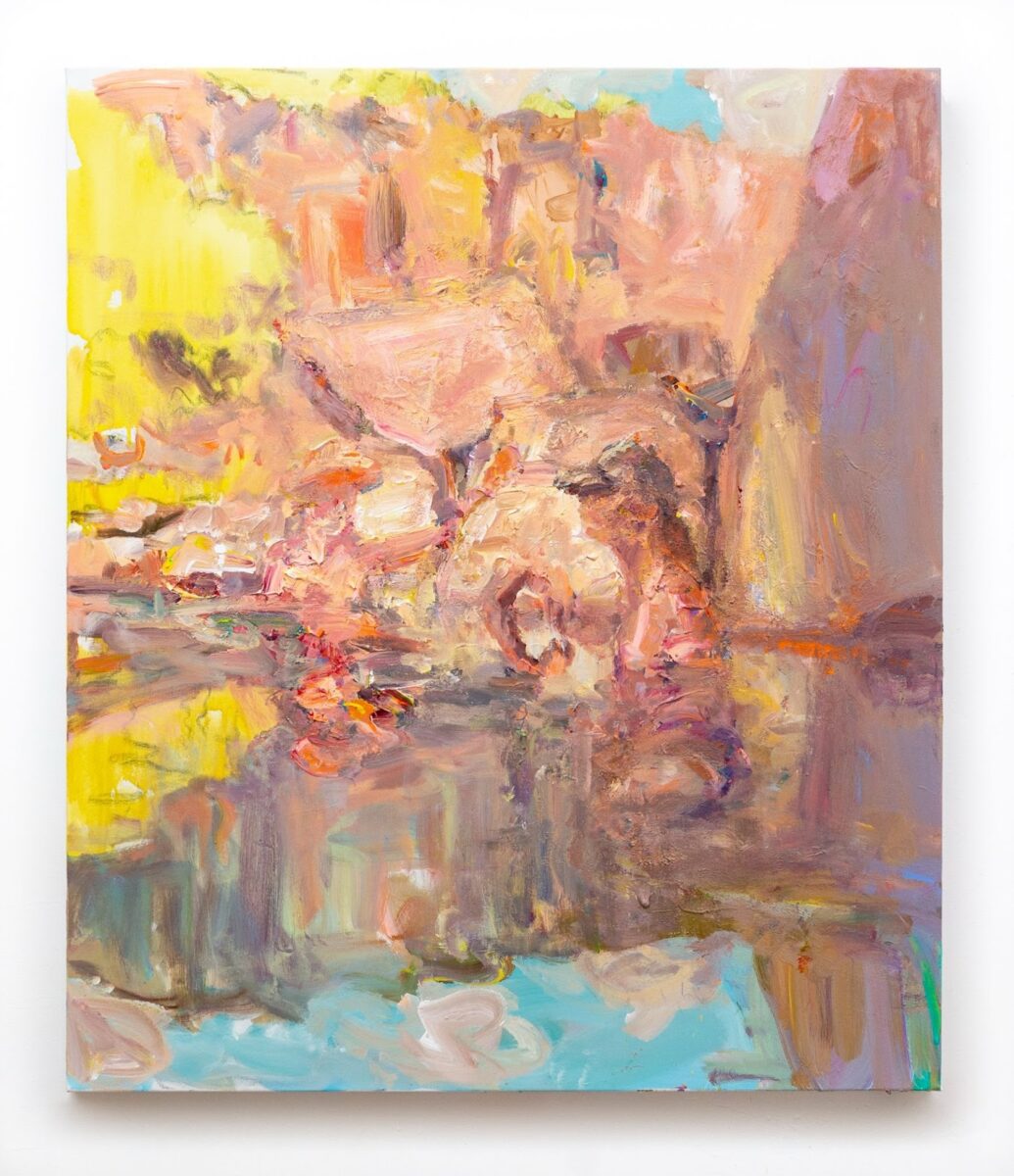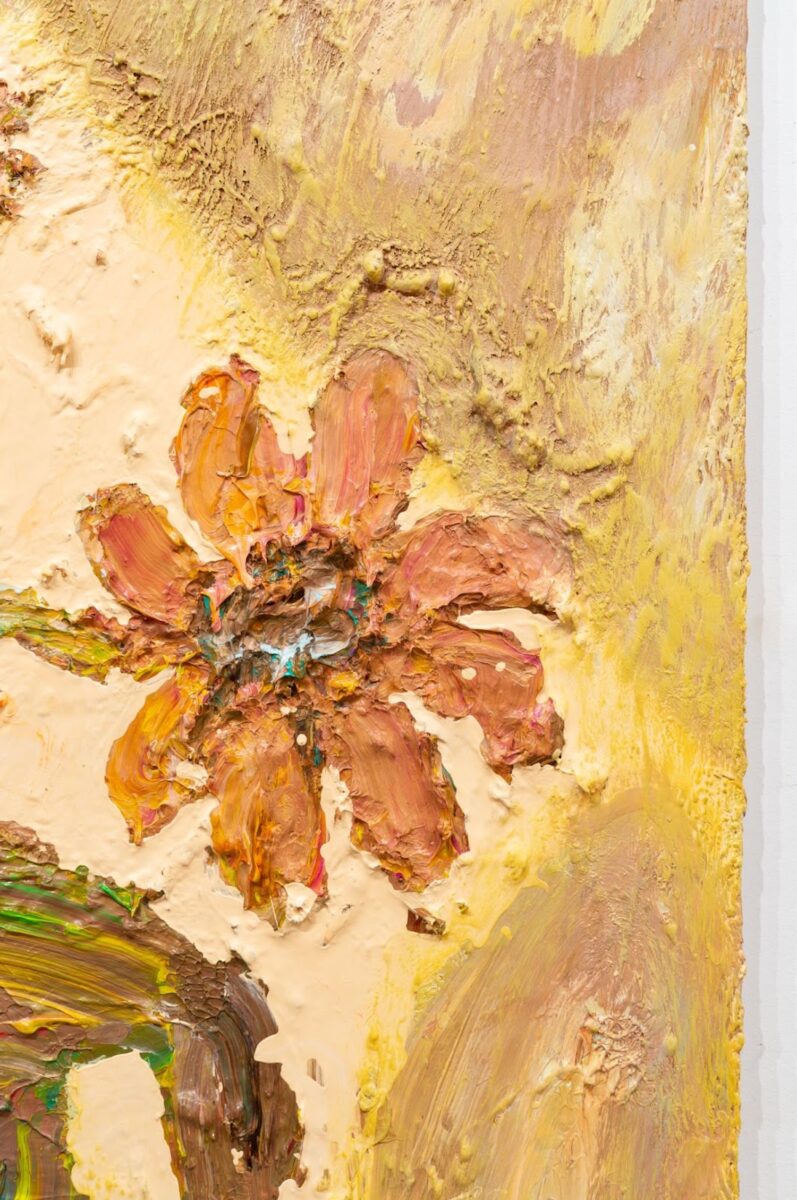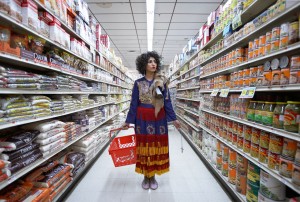
Courtesy of the artist and Massey Klein Gallery, New York.
Emerging Swiss-American impasto painter Chrissy Angliker and established American monumental impasto and resin painter Darius Yektai, of Iranian and Greek heritage, come to artmaking from different cultural perspectives, but connect revealing their shared language of process and materiality. Closing the fall exhibition Chrissy Angliker: Post Liminal at Massey Klein Gallery in New York, Darius Yektai and Chrissy Angliker reflect on the show in-situ to discuss the metaphysical influences of paint as a medium, the poetic energetics of utilizing water’s capacities, the core structures of movement, and the meaning of home. In the wake of a series of sudden losses—her dear friend and motherly figure, her studio of 14 years, and her Brooklyn home—this new body of work has emerged grappling with the resulting wave of instability.

Chrissy Angliker:
That’s Switzerland [Looking On, 2024]. That’s originally where I’m from, so I went there for a while to cool off when Ann passed. And those (paintings) are up in the Alps too.
Darius Yektai:
It was my first time there. It was unbelievable.
Chrissy Angliker:
Well, here we went to a whole different neck of the woods [Oli in the Alps, 2024] where I’ve never been. It was my friend’s chalet in more central, Switzerland. But I show in a gallery in Engadin, near Zuoz, which is right near St. Moritz, so in that kind of area. Where have you gone?
Darius Yektai:
I just went to Verbier and then Zermatt. We were moving quickly, but Zermatt was like a fairy tale. The landscape is incredible.
Chrissy Angliker:
It’s so incredible, and it just has the power to do whatever you can do; like the healing, just being in it, you know?
Darius Yektai:
Especially for you because it’s home. There’s an element of home.
Chrissy Angliker:
That’s what all these interiors ended up showing me, is the essence of home and what home can do, versus the attachment of home. It’s this archetype of going back, it’s giving me all the nurturing I need to be able to come back again, to me. These two in color [It’s Coming, 2024 and Looking On, 2024]–that was very much in the really healing phase. And I don’t know if that happens to you?
Darius Yektai:
Are you speaking about the coolness of the blues? Or are you talking about where it can get into the more disturbed color?

Courtesy of the artist and Massey Klein Gallery, New York.
Chrissy Angliker:
Well, this is the thing. It’s now Post-liminal [Looking On, 2024]. Right after Ann passed both the color and contrast just kind of disappeared, like diluted, there was barely any contrast. The tools that I could work with got extremely small…If I was like, “Oooo, let me have some more color”, then the paint would push back like, “No way!”. It was really like that. Just having these darks and just having contrast again is like, “Oh, okay, we’re getting back online”. These are just the remnants of these hazy colors, hazy contrast, but then you’re starting to have more contrast bringing things back in focus. In this whole show, it was working on resuscitating part of myself that, for a period of time, really had to let go of color just because it wasn’t accessible to me. That’s why I feel it’s so orangey and this is so cool. It was constantly being like “Let’s slowly try to touch reality again”, and then because I’m feeling better in reality again, I feel like that reaction of color was what happened. My reality really had faded. I couldn’t make sense of stuff, and paint usually shows me where I’m at.
Carson Wos: In terms of color versus saturation, would you say that the realism is towards more saturation? Or really pigment and tone, warmth and color?
Chrissy Angliker:
Well, what had happened was that saturation left the picture, so it’s having saturation come back, just having it be fully present. I’m trying to get all my tools to function at their full frequency, so that I can fully work with all of my tools again. It really felt like there was a narrowing of the tools, so I’m just checking in to get them working here again. Unfortunately that’s the hard thing, you can’t fast forward that, but I think it’s getting there. This show to me feels like a very vulnerable place, but also a very optimistic place.
Darius Yektai:
Now I can appreciate more the struggle that you present. I walk into interiors all day…you don’t read interiors as making this much sense. This rectilinear gridding of it, it’s just not how the eye (sees). It seems like you want to take these interiors and make sense of them, adding structure–stability, ultimately–to the work. Then I see art historical references. I do see a lot of Bonnard where the darkness of the figures contrasts the lightness of the backing light. I know your material is different than his, you’re giving us fresh and clean acrylic here and then back to the texture of the canvas. You’re showing us where you had to work a lot harder to make sense of this interior. And the two are coming together. If this texture was across the whole canvas [in the top right section], we would read it as overworked or a little bit heavy. But you don’t, because you give us this freshness of the paint [in the center]. In presenting what you want the interior to be for you, the structural difficulty of forcing it to be stable,–which ultimately I guess is the case for all of us–is that these shelters that we build are delicate.
Chrissy Angliker:
Well, you fully read it. I love what you said, because to me that’s exactly that.
Darius Yektai:
But you really do let the viewer in very well. And then you also show the drawing marks, these lessons from Cézanne. I love these places of breath and air…
Chrissy Angliker:
For me it’s really as you said, this is so important for me, that working in acrylic it’s different than oil, where I can’t wipe something away that I don’t like. The transparency of process you’re pointing out, it’s kind of this honesty of where I’m searching. It’s many times trying to find it, and let it be there, so that we together can see that journey versus it being covered up. But then also knowing the origin–where it started–and moving through the painting more as a poetic conversation than something that should be executed in a certain way. It’s really like each piece is searching for emotional balance.
Darius Yektai:
They benefit each other for certain.
Carson Wos: Are these artists, or others, ones that you draw inspiration from?
Chrissy Angliker:
With Giacometti that’s a different story, because that was one of the earliest artists I was exposed to just being Swiss, and being in the country. But I gravitated to his drawings and paintings. I never really liked his sculpture. But in his drawings and paintings that’s when you see the sculptor’s hand. He’s trying to sculpt, and he’s reaching into this space so that to me is pure magic. I feel that’s deep in there and probably shaped me. I feel like my source as an inspiration, they never really come from outside artists though. That connection comes after.
Darius Yektai:
That’s honest. Yeah that’s pure. It’s like the more you know sometimes.
Carson Wos:
Perhaps you were able to reach a similar frequency, or a similar question, to that artist years ago who entered into a similar emotional landscape?
Chrissy Angliker:
Absolutely, and I feel like that’s how you know.

Courtesy of the artist and Massey Klein Gallery, New York.
Darius Yektai:
Ohh, wow, that’s so Giacometti through the doorway stretching back, in the figures pushing against the door frames [Magic Hour, 2024].
Chrissy Angliker:
But the real carving out of it.
Chrissy Angliker:
New Mexico. Have you ever been?
Darius Yektai:
Yeah.
Chrissy Angliker:
OK, so–you’ve been to Switzerland now–the crazy thing for me is in Taos, I went into these Adobe buildings–it’s high desert–and I’m like ‘Why do I completely feel at home?’. But it was feeling as home–as in Switzerland–, it was bringing up Switzerland! When you go to the Engadin, where I have my Swiss gallery in the Alps, they have similar architecture to the thick walls and big beams. There was just this crazy overlap. There’s nowhere in the States I felt more deeply rooted at home as in Taos, of all places, it’s so crazy to me. For you Magic Hour is also bringing up Giacometti. How funny that this one is the most Giacometti–you know, Swiss–and for me feeling at home. It’s totally Swiss-ing.
Darius Yektai:
It’s Swiss.
Chrissy Angliker:
I mean it’s amazing. But those are the things you can’t plan for. When you let paint have its own vocabulary, then it can suddenly take you in that direction and you’re responding to it. It comes on its own. Then you’re like ‘Whoa! What?’. I didn’t think of that, but you’re so right, yes, you’re so right.
Darius Yektai:
It’s in there probably, because that’s how you grew up. Was Paul Klee also exposed to you there?
Chrissy Angliker:
Yeah, he was. But I didn’t like him at all. I was like ‘He’s so boring’.
Darius Yektai:
He’s so different from one thing to another.
Chrissy Angliker:
Yeah, and all the squares. I’m like ‘No’, because Switzerland. I don’t need more squares.

Courtesy of the artist and Massey Klein Gallery, New York.
Chrissy Angliker:
My previous swimmer paintings didn’t have landscape in it at all, it was almost like you’re in the watery realms. These are the first ones where you’re in the context of landscape, of structure, of home. I specifically painted these in dialogue to interiors where it’s about interior and exterior, it’s so much about letting the light in, and trying to let the light in. Sometimes it’s subdued–it’s really trying to push–but it can’t fully shine. Some of the warmer paintings, they really push, that they almost bleach out everything.
Here light is there–I see it makes more sense. Here if I cropped it just a little more you wouldn’t have any sky. There’s more sky than up there [So Still, 2024], because to me right now reflecting in a mirage makes more sense than the reality itself. For me the reality itself was really heavily unearthed–kind of shattered–in the liminal. Now it’s post-liminal, so I can slowly understand what the hell happened to me.
Darius Yektai:
That’s super interesting.
Chrissy Angliker:
For me, the paintings once they’re done, I can sit with them then they tell me where I’m at. That’s really what I’m looking for. It’s really hard to look at paintings when you’re in that hard place, but I feel now they’re coming back. I can see my progress, and I can also see my level of understanding, also my level of joy coming back. Especially with these cyclical subject matters, they come back in for very specific reasons, in very specific shapes. I usually figure it out once the painting comes through, what they’re really trying to say, because so much happens subconsciously.

Carson Wos: Does the subconscious play an active role in expressing energy released through the body in your painting process?
Chrissy Angliker:
When I paint, it’s all about mirroring reality…I let paint have its own vocabulary, so that I don’t fully control it. That’s where the subconscious comes in, and we can truly have a dialogue. So it’s me and paint, control and chaos, we talk about the subject, and that’s how we shape the subject together. I feel like that’s how we get the more frank representation of what’s really there. When my friend passed, grief did a really big number on my colors.
Darius Yektai:
There’s probably two states of painting. There’s when you’re in this fast reactionary (moment) to the surface, when it’s like this mystical (energy). You’re all in, you have your colors, you’re moving fast, things are dripping, you’re not looking, you’re staying very close to the canvas–an arms length away–, and you haven’t stepped back to evaluate. A lot of times you’re doing, doing, doing and it’s good to keep going into the end of your thought, because when you step back sometimes it’s done, and you never get to go back in again.
But if I’m looking at something from a distance, thinking and picturing the variations in your brain, I can physically think about what it would look like if the yellow parts were green in your brain. It’s only when it nags at you, then you mix-up the green, and you change it. Then it’s a very conscious mark that gets made. Some of my marks, because there are trowels and liquid resins that have to be made before,–so you load the trowel–that is very conscious. But you’re also conscious of the fact that when you go in you have one chance. Then there’s an element of chance that happens as well, and you let that happen.
Chrissy Angliker:
Totally, totally, that’s so true. I feel that for me it’s speed, once I start painting it’s like taking a deep breath, and then it’s one big meditative state until I can’t hold the focus anymore. None of it is slow. Everything is fast–it’s like trying to push out feeling. I know when a painting’s finished, when it feels like ‘This is what I was feeling’, then it’s like ‘You’re done’. That’s the indicator. I’ll jump in when I’m full of that feeling that needs to be unloaded, and then I’m searching, searching, searching. In searching, paint is such a big help. To me paint, it’s like this intermediary to the subconscious, because I let it have its own vocabulary. Then it will just push back, and I’m like ‘Ohh, interesting, is that what we’re talking about?’ Then we can have that dialogue. Paint–it’s doing its own thing–has a huge part in helping get to the pain–into that feeling–because having a feeling is conscious and self-conscious. It all happens real fast, then some paintings happen in one go. But then some other ones go on–there’s always speed–if I go in again, it’s another fast go. I think it needs to be reconnecting with the dynamic of ‘There’s no fixing, there’s only searching’.
Darius Yektai:
It’s the problem solving. It’s the surprises that happen in the painting that reveal the poetry. To you, it’s not necessarily, ‘I’m not so in control over the poetry’, if that makes sense? But I know it when it happens. At home I have to feel grounded in order to paint. Maybe that is what this whole show is about? That you’re starting to feel grounded.
Chrissy Angliker:
Yeah, like searching. When everything is ripped from underneath you, it’s pretty amazing that at the end these paintings were good things that became the constant. Because everything else wasn’t.

Courtesy of the artist and Massey Klein Gallery, New York.
Darius Yektai: I like your line: “and in still waters it takes one drip to remember”. It’s got a lot of meanings and layers to that one line. That the one drop would activate the surface and set it alive. That is water.
Chrissy Angliker:
Yeah, and it would shatter the illusion…
Darius Yektai:
…shattered the comfort of, the stability of. Which is interesting what you’re saying about groundedness. Then I was thinking about how the reflections of the bottom half of the canvases are reflections on water. That’s not necessarily grounded, it’s the opposite.
Carson Wos:
But maybe that is the release? Finally allowing movement back in.
Carson Wos: It seems like a conversation about movement. The movement of water, as energy, can be mapped as a wave, and the movement of light, as a photon, can be mapped as a wave. Emotions also have movement: they can get stuck in the body, or they can flow through it to a new phase of healing. In this show, do you find that light or water has greater capacity for movement during this tumultuous time?
Chrissy Angliker:
I think water. It’s just how it’s helping me loosen my state of mind, and to loosen me up in general. Just wanting to paint water indicates I’m ready to be more in flow versus sort of resistant. It’s really nice. That’s why I’m so happy when that subject pops back up, because that’s my favorite time with physical movement. It can help with the way I paint as the body is part of the painting.

Courtesy of the artist and Massey Klein Gallery, New York.
Darius Yektai:
I was thinking your answer was gonna be light, because that is a very prominent, hopeful, really specific moment of light saving the composition, giving it depth [Late Blooms, 2024]. That’s the last thing that you painted on the surface, and is the furthest thing that your eye shoots deep into. This is a really awesome painting, with the freshness of this, and the chosen oddity of that. That’s perfect. Then this is so worked on and struggled with, yet in the end you solved it perfectly. Yet this is fresh and these moments are cool toned. Fluorescent paint. Not easy. Not easy at all.
Chrissy Angliker:
Thank you for seeing all of that.
Darius Yektai:
Yeah and this light is also watery. It’s super watery.
Chrissy Angliker:
That’s what I was just gonna say. That kind of brings both of your points together, where this was solved by pouring [Late Blooms, 2024]. The reason for pouring was to quiet down this, as this is all so overworked. ‘How do I bring stillness back?’ It’s tortured. ‘How do you balance it all out?’ and ‘How can the differently painted parts still communicate?’. This is completely filled, while this is not, but then you can just let it pour, and let it sit. Let it become completely quiet. It’s so funny within one painting you can remember and forget so many things. Towards the end then it’s like ‘Ohh, you just want to have quiet light’. There’s so much more movement.

Darius Yektai:
It’s a really good painting.
Chrissy Angliker:
Thank you.
Darius Yektai:
Yeah, it’s interesting. There’s a lot of layers to the subject and the wording that you’re putting to these paintings right now. What’s next?
Chrissy Angliker:
Post-show, you have a little bit of pressure off, so I can just pump that joy and energy. I want to really stay in touch with that looseness and the joy I get from painting. This exploration, the last year and a half, was extremely difficult but extremely rich. Just to be able to touch joy, and morph that into looseness, I need to give that to myself. I’m in that right now and just still resuscitating the color. In my head there’s also this mantra, ‘trying to get closer to reality’ not necessarily in mark, but just in color, in contrast, because I was so far from it for so long. It was disorienting. Just getting really grounded in reality, so that I can get more abstract.
About the Exhibiting Artist:
Chrissy Angliker has presented solo presentations in New York, California and extensively in Switzerland. The artist has participated in the Dallas Art Fair, Texas (2024), the Future Fair, New York (2023), Zurich Art Fair, Zurich, Switzerland (2022), and in GAF Art Fair, Amsterdam, Netherlands (2014). Angliker has been featured on David Zwirner’s PLATFORM and has been honored as a recipient of the International Takifuji Art Award (Tokyo, Japan). Angliker is represented by Massey Klein Gallery.
To learn more about Chrissy Angliker, follow her on Instagram @chrissyangliker or contact Massey Klein Gallery.
About the Guest Artist in Conversation:
Darius Yektai is an established second-generation artist, who has developed a chemically technical process of encasing thick layers of oil paint beneath and upon cast resin surfaces. Darius Yektai has exhibited internationally in London, Marbella, Mykonos, and Dubai, as well as being curatorially selected for exhibition in Art Basel Miami fair and Phillips de Pury & Co., NY.
To learn more about Darius Yektai, follow him on Instagram @darius_yektai or contact Greening Gallery.





